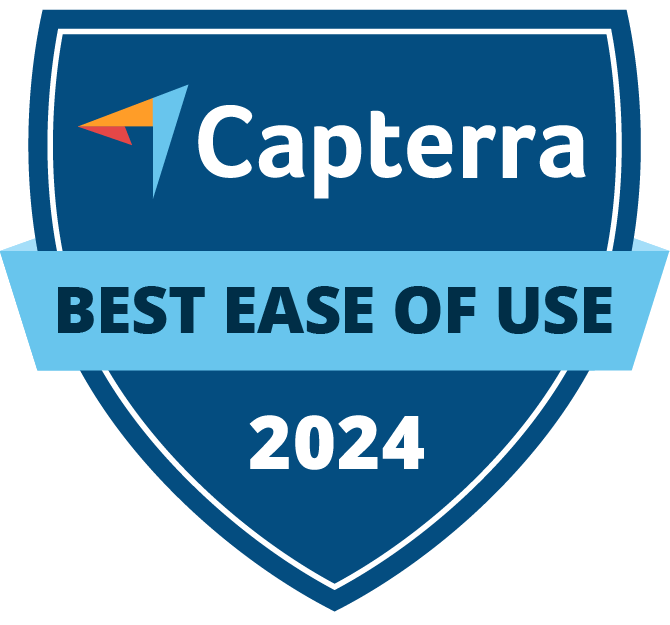ARPU and Customer Segmentation: how to optimize revenue per user

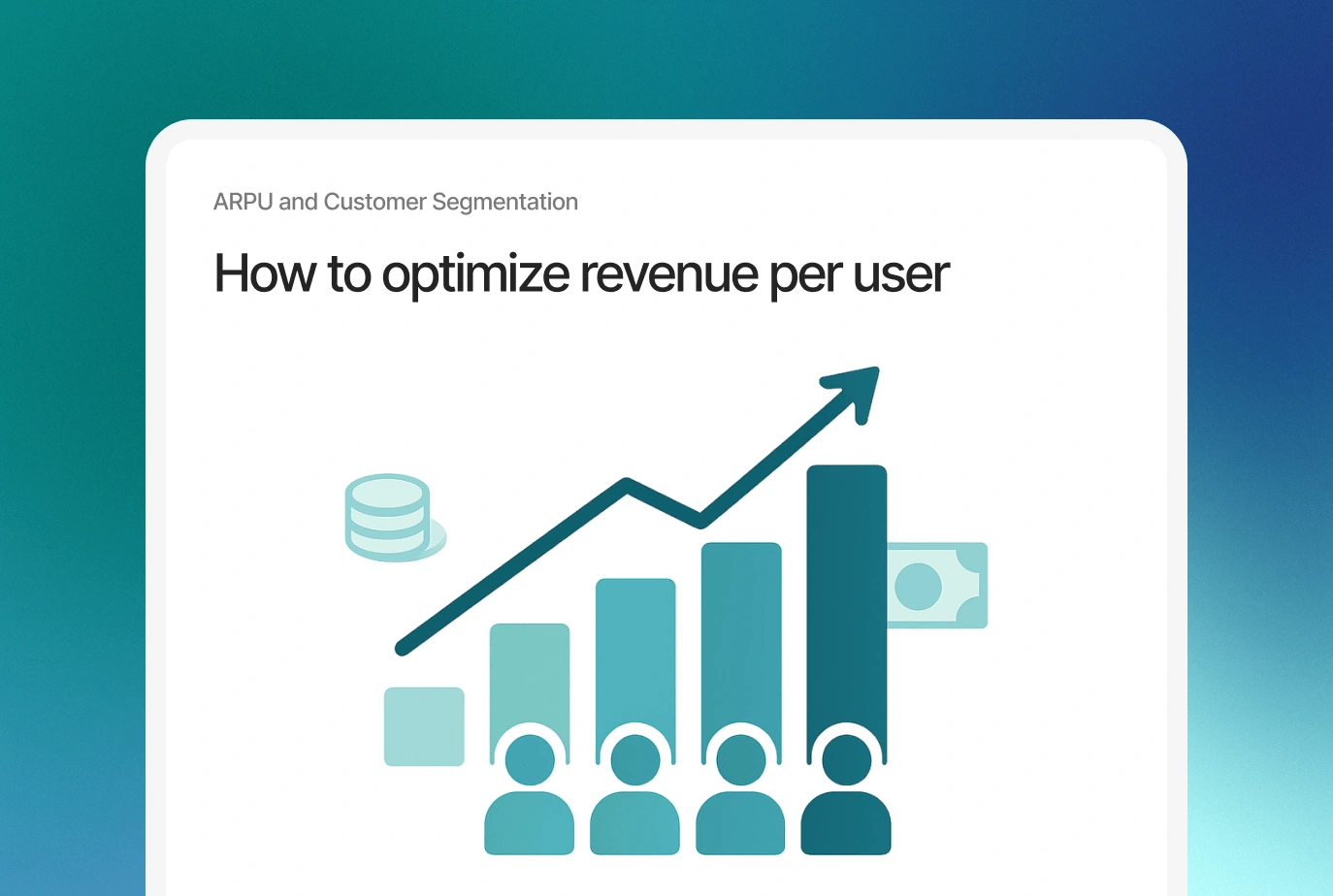
Revenue per user is more than a metric when it comes to SaaS growth: it's a strategy. Average Revenue Per User (ARPU) provides a clear lens through which to evaluate the health of your pricing strategy, customer segmentation, and monetization tactics. When tracked and leveraged correctly, ARPU becomes one of the most powerful growth levers at your disposal.
However, simply tracking ARPU won’t move the needle. SaaS leaders must understand how different customer segments contribute to revenue and how to act on those insights strategically. This article examines how to analyze, segment, and optimize your Average Revenue Per User (ARPU) to achieve more substantial margins and scalable growth.
Understanding ARPU in a SaaS context
Before diving into tactics, it's essential to understand the fundamentals of ARPU and its critical role in a SaaS business. This section will define the metric and highlight its strategic importance, extending beyond its financial KPI significance.
What is ARPU?
ARPU is calculated by dividing your total Monthly Recurring Revenue (MRR) by your total number of active users or customers within a given period.
ARPU = MRR / Number of Active Customers
This metric indicates the average contribution each user makes to your revenue. It helps founders and CFOs understand the efficiency of monetization across the customer base. When tracked over time and analyzed by segment, ARPU provides insight into customer value, pricing strategy effectiveness, and potential upsell opportunities.
Why ARPU matters more than you think
Many SaaS teams focus heavily on growth through acquisition. But acquisition alone won’t build a sustainable business if monetization isn’t working. ARPU tells you if you are growing profitably. A rising ARPU might indicate better pricing strategy, more upsells, or a shift toward higher-value users.
On the other hand, flat or declining ARPU could be a red flag: are you attracting the wrong customers? Are you over-discounting? Are power users churning?
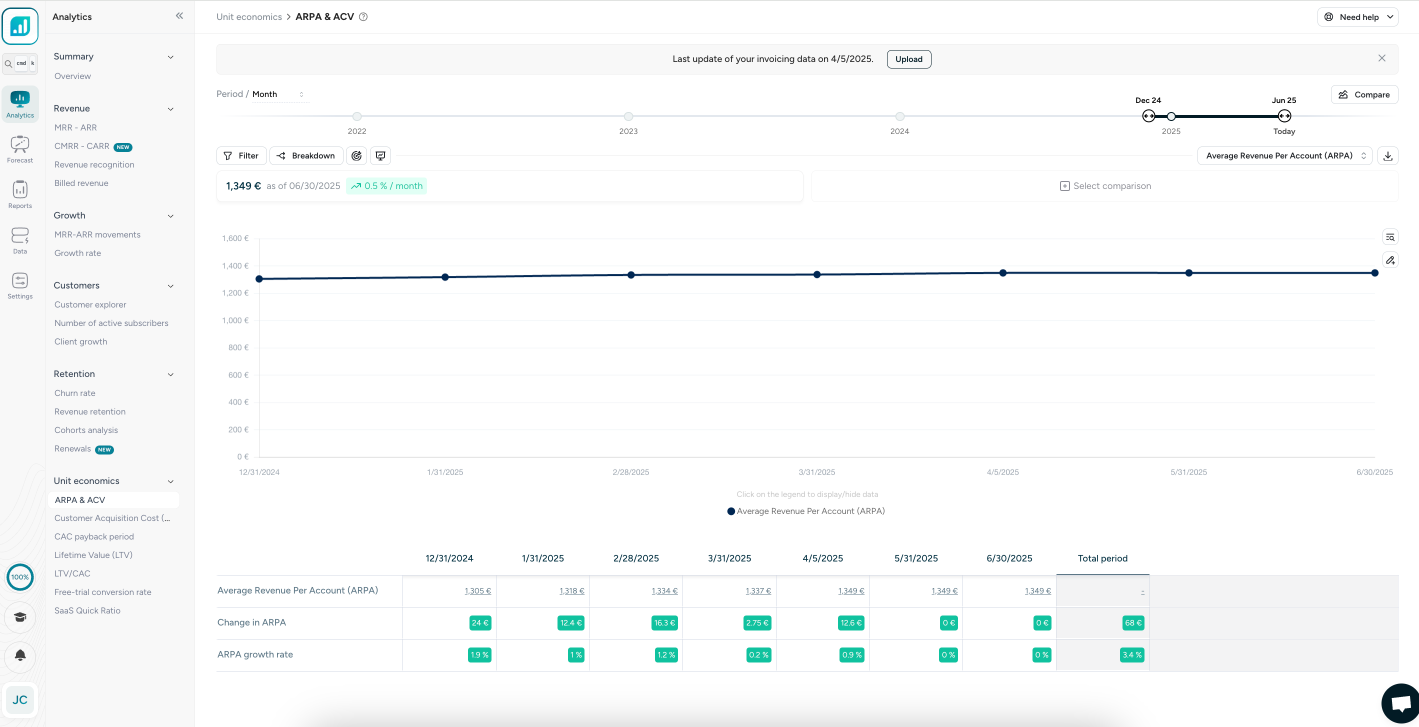
Segmenting customers to decode ARPU drivers
To truly understand what drives ARPU, you need to go beyond the average. Segmenting customers enables you to identify which types of users generate the most revenue, have a longer lifetime, or are more likely to expand.
Segment by company size
Different business sizes bring very different ARPU profiles:
- SMBs typically generate lower ARPU but have shorter sales cycles and scale through volume.
- Mid-market customers offer better upsell potential and a moderate average revenue per user (ARPU).
- Enterprise customers yield high ARPU, often with longer sales and onboarding cycles.
Industry analyses suggest that enterprise customers typically contribute significantly more revenue per user compared to SMBs.
For instance, Jason Lemkin notes that HubSpot has twice the revenue of Monday.com, despite both companies having a similar number of customers, implying a higher ARPU for HubSpot. Additionally, HubSpot's investor presentation indicates that over 45% of their Annual Recurring Revenue (ARR) comes from customers using three or more hubs, which is more common among larger, enterprise clients.
{{discover}}
Segment by industry
Your product might solve different problems depending on the customer’s industry. For example, a BI tool might generate $200 per month from a small marketing agency but over $5,000 per month from a fintech scale-up.
SaaS companies in finance and analytics often achieve higher Average Revenue Per User (ARPU) due to the complex nature of their workflows, the demand for advanced reporting capabilities, and the need for deeper integrations.
Segment by usage behavior
Behavioral segmentation includes:
- Power users: Engage daily, use multiple features.
- Casual users: Use only a subset of features.
- Dormant users: Low activity, likely to churn.
Mapping these segments to ARPU reveals gaps in monetization. If casual users have higher-than-expected ARPU, they might be overpaying, which could trigger churn.
Segment by customer lifecycle
New users typically start on lower tiers, while mature customers may have expanded usage over time. Segmenting ARPU by lifecycle stage helps you measure:
- How well your upsell and expansion strategies are working
- Whether long-term customers are increasing in value
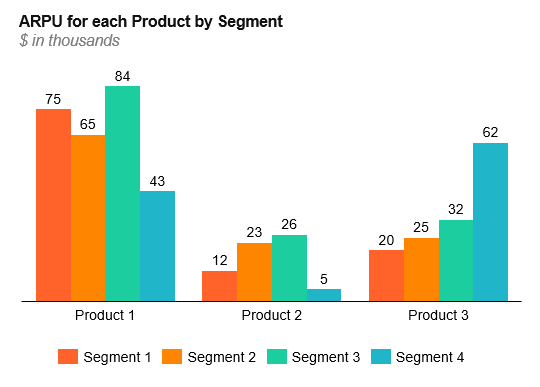
Source: www.produxlabs.com/blog/b2b-saas-top-line-metrics-getting-more-out-of-your-revenue-measurements
How to grow ARPU: 5 concrete levers
After analyzing your segments, the next step is taking targeted action. This section offers tactical ideas for increasing ARPU in ways that align with your customers' specific needs and behavior. These five proven strategies can help lift revenue while maintaining or improving customer satisfaction.
- Personalize upsells and cross-sells
Use segmentation data to tailor upsells:
- Offer additional seats or storage to growing SMBs
- Sell automation features to mid-market clients
- Provide compliance or API access to enterprises
For example, TechSolution implemented a customer loyalty program that led to a 35% increase in ARPU.This was achieved by encouraging upsells and cross-sells to higher-tier plans, demonstrating the effectiveness of targeted customer engagement strategies.
Another example is KPI6, a SaaS company that leveraged growth capital and AI integration to enhance its offerings. As a result, they experienced a 200% year-over-year increase in ARR and a 174% rise in CLV, indicating a significant uplift in ARPU.
- Use smart pricing tiers
Pricing should reflect the perceived value of each segment. Create distinct tiers that encourage upgrades.
Emeric Ernoult, CEO of Agorapulse, recommends adjusting only one part of your pricing at a time. This allows you to measure the impact without disrupting your whole model. Emeric also warns against setting prices too low, as this can suppress ARPU and hinder future growth. Instead, aim for pricing that reflects the actual value delivered.
- Introduce usage-based pricing (UBP)
UBP enables you to scale revenue as your customer base expands. This works especially well in developer tools, analytics, and infrastructure-as-a-service (IaaS) solutions.
- Reduce over-discounting and legacy pricing
It’s common for early-stage SaaS companies to lock in legacy customers at low prices. But over time, this drags down ARPU. Establish a clear process to phase out outdated plans and transition older users to current pricing tiers.
Discounting should be limited and tied to specific outcomes, such as multi-year contracts or volume commitments.
- Re-engage low-ARPU users
Instead of letting low-paying or disengaged users churn, use onboarding and feature activation to unlock more value.
In April 2017, ConvertKit implemented a strategy involving custom onboarding emails tailored to the user's platform and email service provider. This approach involved sending personalized welcome videos to new users, resulting in a 14.7% decrease in churn for that month. These personalized interactions made users feel more connected and supported, contributing to improved retention rates.
Common pitfalls when optimizing ARPU and how to avoid them
Not all ARPU growth strategies lead to long-term success. In fact, some can hurt customer retention or obscure important revenue patterns.
- Don’t sacrifice retention for short-term ARPU gains: It’s tempting to focus on high-paying users and abandon low ARPU segments. But be careful - ARPU growth shouldn’t come at the cost of higher churn.
- Don’t use a one-size-fits-all model: Each customer segment may respond differently to pricing strategies. For instance, usage-based pricing might work for enterprises but may scare off small to medium-sized businesses (SMBs). Test different pricing models across customer types. Run A/B tests before rolling out significant changes.
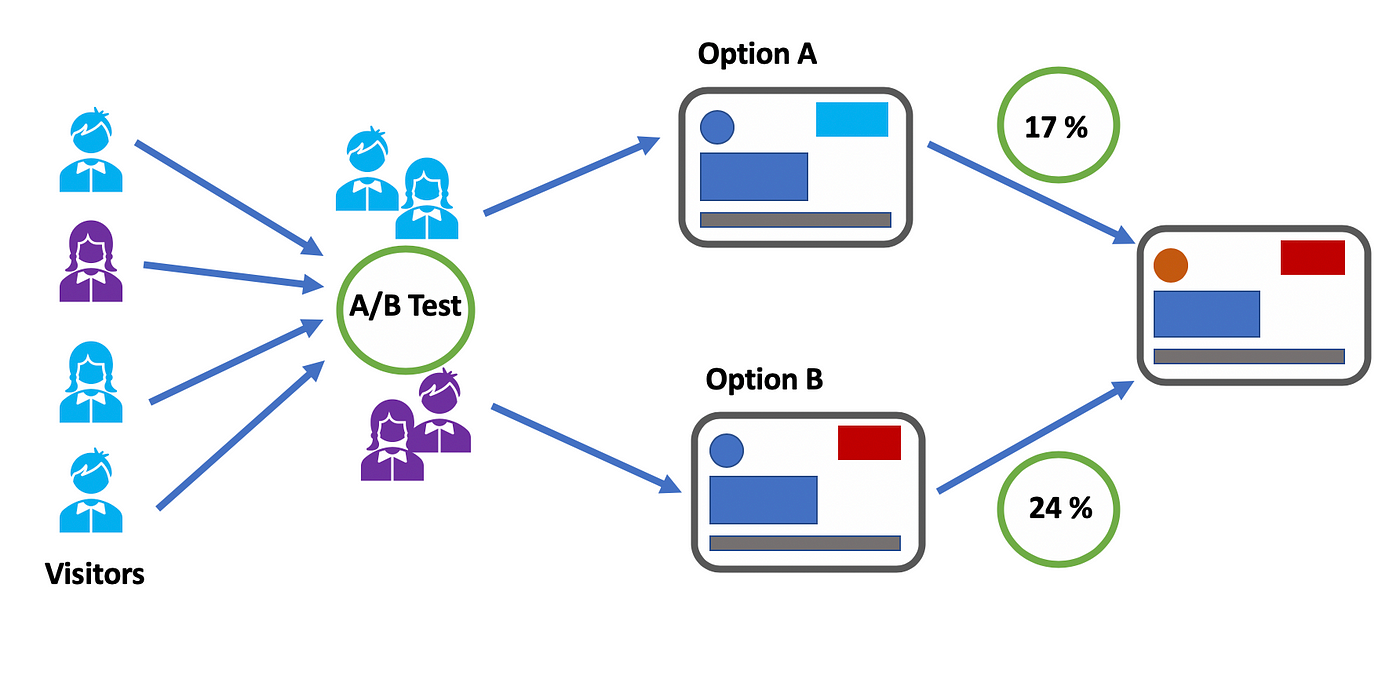
Source: https://medium.com/data-science/how-to-conduct-a-b-testing-3076074a8458
- Don’t rely solely on average ARPU: ARPU is useful, but averages can hide outliers. Always pair ARPU analysis with the following metrics to get a fuller picture of revenue quality:
Measuring and iterating for success
Optimizing ARPU is not a one-time project but a continuous process. It's essential to understand what metrics to measure alongside ARPU and how to foster a culture of experimentation, enabling your monetization strategy to continually evolve.
What to track beyond ARPU
Here are the supporting metrics you should monitor:
- Segmented ARPU: Track ARPU by company size, plan, and geography
- Expansion MRR: Measures how much revenue comes from existing customers upgrading
- NRR: Net Revenue Retention = Revenue retained + expansion – churn
- LTV/CAC Ratio: Helps you assess the long-term value of different segments
Learn more by reading our article here.
Build a test-and-learn culture
In order to find what works best for your SaaS, you can treat every pricing or product change as an experiment. For each initiative:
- Define your hypothesis (e.g., "Adding feature X will increase ARPU by 10%");
- Identify your test segment;
- Measure the impact;
- Scale what works.
For example, Notion exemplifies a test-and-learn approach: before fully launching its “Personal Pro” plan, the team tested it with power users to validate its impact on average revenue per user (ARPU) without affecting team subscriptions. The experiment proved successful, helping to refine their freemium strategy.
Conclusion
Used strategically, ARPU can become a strategic lever for SaaS founders. Optimizing ARPU requires deep understanding of your customer base, constant iteration, and disciplined testing.
By segmenting users based on size, behavior, industry, and lifecycle, and aligning pricing with value delivered, you can build a healthier, more predictable revenue engine.
Avoid falling into the trap of chasing growth solely through volume. Instead, try to focus otracting the right users and serving them better over time. When you combine ARPU insights with strategic segmentation, you set your SaaS business on a path toward sustainable, profitable growth.
{{newsletter}}


Discover Fincome!

Frequently Asked Questions
Expense Tracking:
Fincome is a SaaS revenue management platform designed specifically for companies with recurring revenue models (any business selling subscriptions).
Fincome automates the tracking and management of your revenues and associated KPIs (churn, LTV, CAC, etc.) in real time, without the need for a data team or manual processing, thanks to direct integrations with your billing systems and ERP.
Unlike generic BI tools, Fincome offers a turnkey, intuitive solution tailored to the specific needs of subscription-based businesses, enabling seamless collaboration across your finance, GTM, and CSM teams.
Fincome is built exclusively for companies with recurring revenue models, meaning those that track MRR or ARR, such as:
• Software publishers (SaaS)
• Media companies
• Mobile apps
• Any other B2B or B2C subscription business looking to professionalize revenue management
Fincome supports organizations at every stage of growth, from startups to mid-market and large international enterprises.
With Fincome, you gain access to a full suite of modules:
✅ Revenue: detailed ARR/MRR breakdown, cohort analysis, detection of billing errors or omissions, revenue recognition and deferred revenue (PCA)
✅ Growth: analysis of ARR movements (new business, expansion, churn, reactivation), identification of growth drivers
✅ Unit Economics: LTV, CAC, and LTV/CAC analysis by segment, channel, or geography to optimize margins
✅ Retention: deep cohort analyses, identification of key retention drivers
✅ Renewals: future MRR projections, opportunity forecasting, and churn risk reduction
✅ Forecasting: revenue growth scenario modeling to better inform strategic decisions
Fincome is the only turnkey platform built specifically for recurring revenue businesses that combines:
✅ A complete, reliable view of your recurring revenues (MRR, ARR, churn, LTV, CAC, cohorts, renewals, revenue recognition, deferred revenue)
✅ Fully customizable, automated, shareable reports powered by AI, delivering actionable insights to guide your strategic decisions
✅ Expert support to help structure and interpret your analyses, without needing to build an internal data team
✅ The ability to generate future growth scenarios, compare them side by side, and track actual vs. forecasted performance, all in real time
Unlike traditional BI tools, which require you to build and maintain your own metrics (often consuming internal resources just to produce static data visualizations), Fincome transforms your SaaS metrics into concrete, actionable recommendations — helping you move faster, with more impact and operational efficiency.
Yes! If you use an unlisted or in-house billing system, no problem — you can easily import your billing data via Excel or push it through our public API. You can access our public API documentation here.
With Fincome, you can:
✅ Reduce up to 90% of the time spent calculating and reporting your KPIs
✅ Make faster, more accurate strategic decisions
✅ Recover up to 5% of lost revenue by detecting errors or omissions
✅ Cut the risk of manual spreadsheet errors by 80%
Absolutely. Data security is at the heart of what we do. Fincome is SOC 2 Type I certified, ensuring a high level of data security and protection.
Your data is collected exclusively via read-only APIs and hosted on secure servers located in France. We never share your data with third parties without your consent.
For a detailed review of our security practices, please visit our dedicated security page.
At Fincome, customer success is a core priority. We guide you from the very start — structuring your data, training your teams, and optimizing your use of the platform to deliver value quickly.
Our team remains by your side to answer strategic or technical questions, share best practices, and help you get the most out of your analyses.
Simply request a demo on our website. We’ll walk you through the platform, assess your needs, and guide you through a smooth deployment.
Most deployments and team trainings take no more than two weeks to get fully up and running.
👉 Request a demo
Income Analytics:
Lorem ipsum dolor sit amet consectetur adipiscing elit etiam vehicula. Etiam vehicula condimentum nunc, a semper elit luctus id. Duis fringilla enim non neque aliquet.
Lorem ipsum dolor sit amet consectetur adipiscing elit etiam vehicula. Etiam vehicula condimentum nunc, a semper elit luctus id. Duis fringilla enim non neque aliquet.
Lorem ipsum dolor sit amet consectetur adipiscing elit etiam vehicula. Etiam vehicula condimentum nunc, a semper elit luctus id. Duis fringilla enim non neque aliquet.
Budget Management:
Lorem ipsum dolor sit amet consectetur adipiscing elit etiam vehicula. Etiam vehicula condimentum nunc, a semper elit luctus id. Duis fringilla enim non neque aliquet.
Lorem ipsum dolor sit amet consectetur adipiscing elit etiam vehicula. Etiam vehicula condimentum nunc, a semper elit luctus id. Duis fringilla enim non neque aliquet.
Lorem ipsum dolor sit amet consectetur adipiscing elit etiam vehicula. Etiam vehicula condimentum nunc, a semper elit luctus id. Duis fringilla enim non neque aliquet.
Wealth Management:
Lorem ipsum dolor sit amet consectetur adipiscing elit etiam vehicula. Etiam vehicula condimentum nunc, a semper elit luctus id. Duis fringilla enim non neque aliquet.
Lorem ipsum dolor sit amet consectetur adipiscing elit etiam vehicula. Etiam vehicula condimentum nunc, a semper elit luctus id. Duis fringilla enim non neque aliquet.
Lorem ipsum dolor sit amet consectetur adipiscing elit etiam vehicula. Etiam vehicula condimentum nunc, a semper elit luctus id. Duis fringilla enim non neque aliquet.






